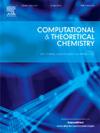Theoretical investigation of the energy transmission mechanism in phthalocyanine-benzimidazole photosensitizers used for singlet oxygen generation
IF 3
3区 化学
Q3 CHEMISTRY, PHYSICAL
引用次数: 0
Abstract
The present work is focused on investigating the spatial factors regarding the energy transmission mechanism occurring in four second-generation phthalocyanine-benzimidazole photosensitizers proposed for singlet oxygen production (H2Pc, ZnPc, GaClPc and InClPc) through analyses from the Quantum Theory Atoms in Molecules (QTAIM). Hence, electron and spin densities obtained by means of Density Functional Theory (DFT) are considered here. The QTAIM quantities calculated for these phthalocyanines allowed us to investigate the atoms presenting the most relevant variations in the electronic structure moving from the singlet ground state to the first triplet excited state, , indicating the regions of the photosensitizers where the transmission of energy from these molecules to oxygen (O2) could take place. This analysis was corroborated by spin densities that pointed out the positions where the highest rates of singlet oxygen formation would take place. Hence, the nitrogen and mainly carbon atoms from the inner phthalocyanine ring are pointed as the docking sites for energy transmission aiming singlet oxygen generation from phthalocyanine-benzimidazole photosensitizers. Finally, while the spatial features seen in metallophthalocyanines remain similar for all metals in the oxidation states considered here [Zn(II), Ga(III) and In(III)], the H2Pc compound shows small differences with the respect.

单线态制氧用酞菁-苯并咪唑光敏剂能量传递机理的理论研究
本文通过量子理论原子在分子(QTAIM)的分析,研究了四种第二代酞菁-苯并咪唑光敏剂(H2Pc、ZnPc、GaClPc和InClPc)单线态产氧的能量传输机制的空间因素。因此,本文考虑了用密度泛函理论(DFT)得到的电子密度和自旋密度。对这些酞菁计算的QTAIM量使我们能够研究从单线态基态到第一三重态激发态(S0→T1)的电子结构中表现出最相关变化的原子,这表明光敏剂分子向氧(O2)传输能量的区域可能发生。这一分析得到了自旋密度的证实,自旋密度指出了单线态氧形成速率最高的位置。因此,将内酞菁环的氮原子和主要的碳原子作为酞菁-苯并咪唑光敏剂产生单线态氧的能量传递的对接位点。最后,虽然金属酞菁在这里所考虑的氧化态[Zn(II), Ga(III)和in (III)]中所看到的空间特征是相似的,但H2Pc化合物在这方面表现出很小的差异。
本文章由计算机程序翻译,如有差异,请以英文原文为准。
求助全文
约1分钟内获得全文
求助全文
来源期刊

Computational and Theoretical Chemistry
CHEMISTRY, PHYSICAL-
CiteScore
4.20
自引率
10.70%
发文量
331
审稿时长
31 days
期刊介绍:
Computational and Theoretical Chemistry publishes high quality, original reports of significance in computational and theoretical chemistry including those that deal with problems of structure, properties, energetics, weak interactions, reaction mechanisms, catalysis, and reaction rates involving atoms, molecules, clusters, surfaces, and bulk matter.
 求助内容:
求助内容: 应助结果提醒方式:
应助结果提醒方式:


